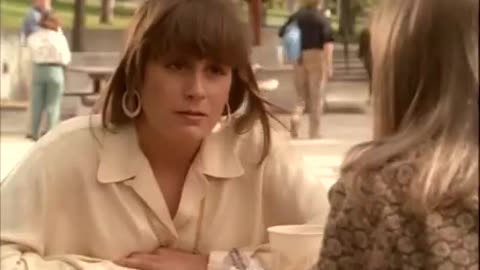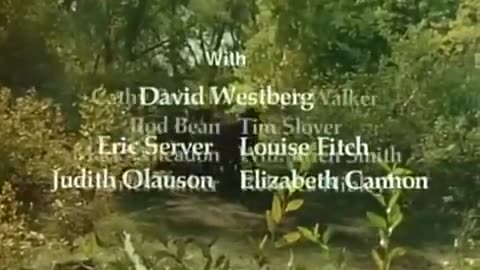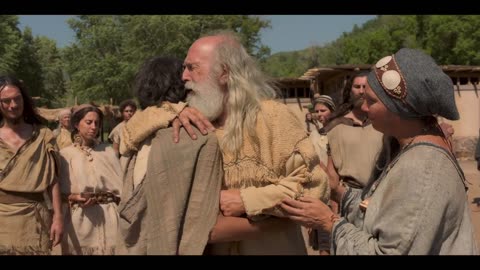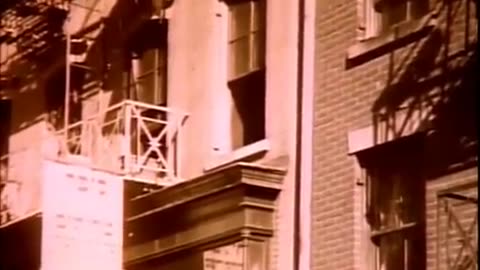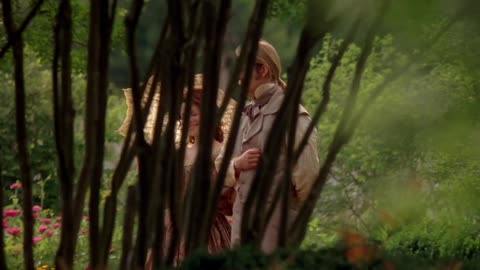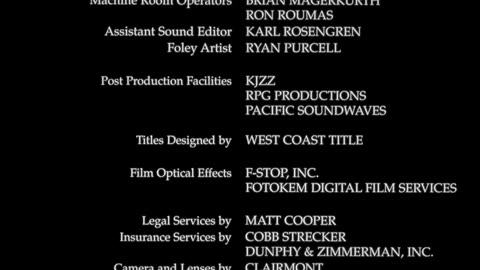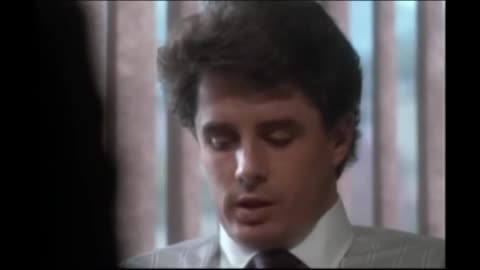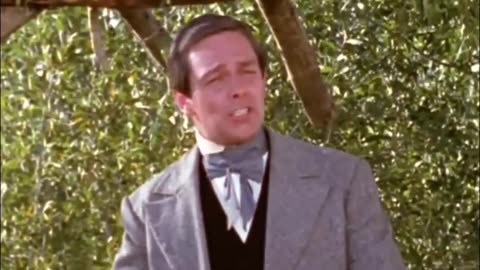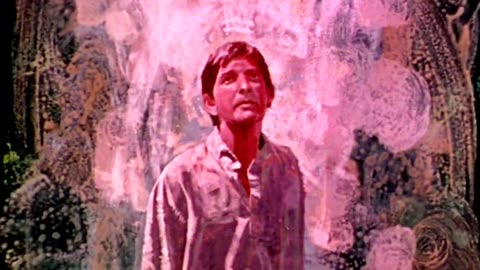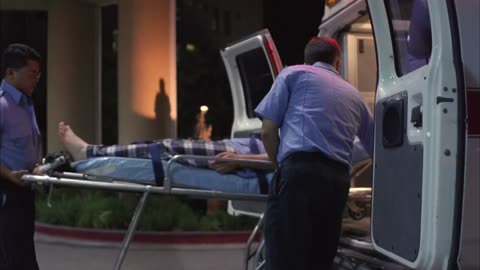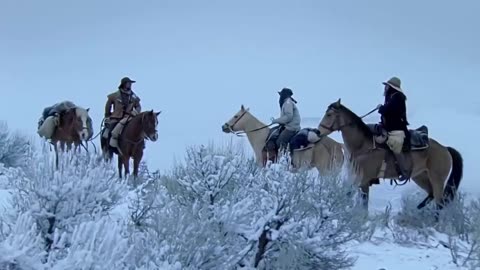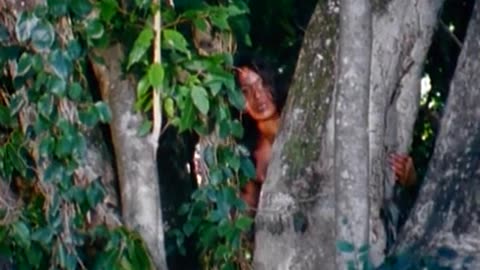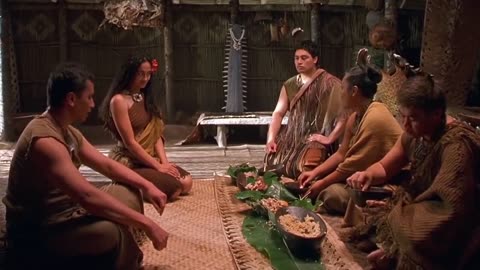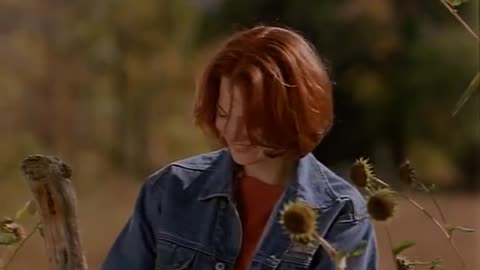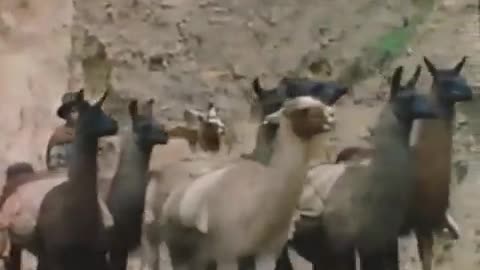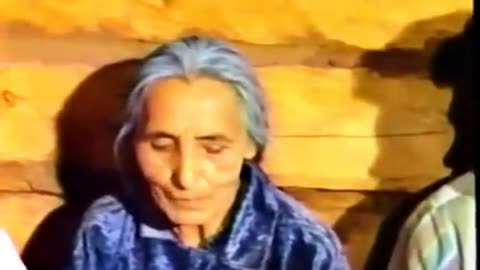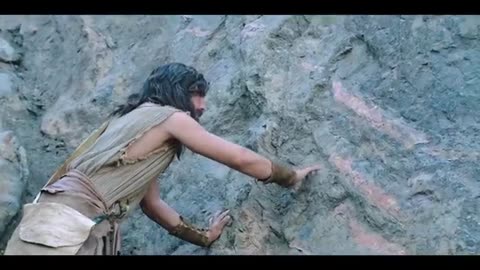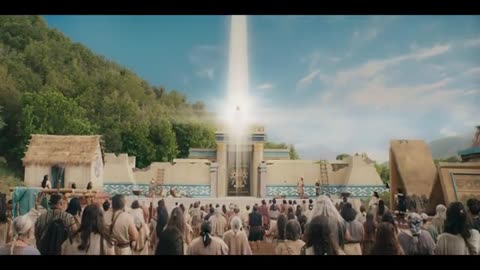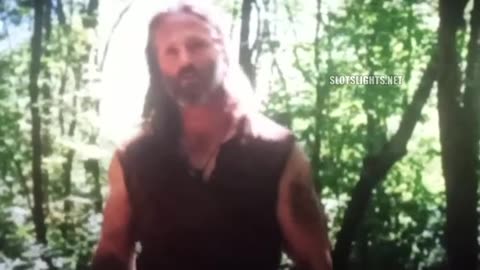Premium Only Content
This video is only available to Rumble Premium subscribers. Subscribe to
enjoy exclusive content and ad-free viewing.
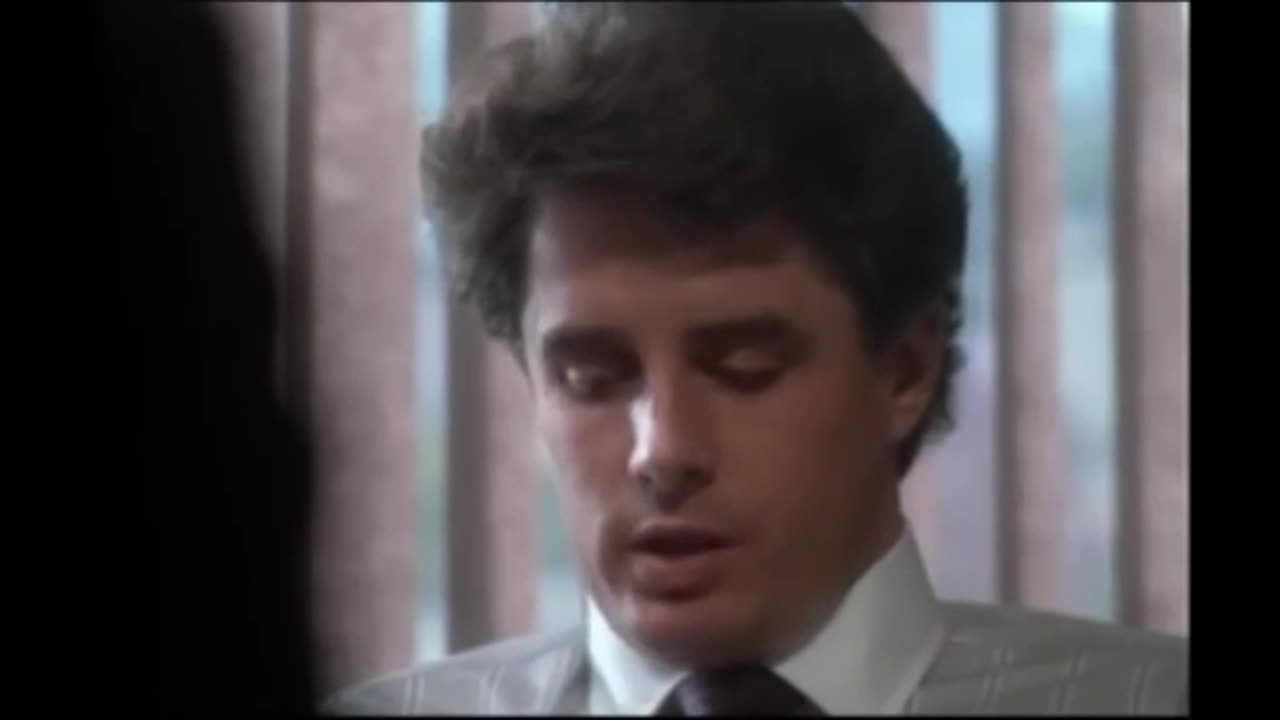
Mormon Movies
TheAmericanObserver
- 13 / 33
1
On the Way Home (1992)
T
The Mormon Observer
Through the influence of a friend, a family finds that the gospel of Jesus Christ can help them improve their relationships, resist temptations, and answer questions posed by the loss of a family member.
2
Morality for Youth (1982)
T
The Mormon Observer
Morality for youth / [Church of Jesus Christ of Latter-day Saints], 1982
Sub-Series — Reel: 23Identifier: UA 5625 Series 2 Sub-Series 10
L. Tom Perry Special Collections. University Archives David Kent Jacobs collection on Mormon films (UA 5625) David Kent Jacobs collection of films, 1955-1988 Morality for youth / [Church of Jesus Christ of Latter-day Saints], 1982
Scope and Contents
Film was released in 1982, and was produced by Brigham Young University Motion Picture Department for the Church of Jesus Christ of Latter-day Saints. The story focuses on an analogy between a rafting trip and the dangers of sexual immorality. The collection has one copy of the film on a film reel. Dated 1982.
Dates
1982
Creator
Church of Jesus Christ of Latter-day Saints (producer, Organization)
Conditions Governing Access
Open for public research. Films are kept in cold storage; access requires 24 hours advance notice.
Conditions Governing Use
It is the responsibility of the researcher to obtain any necessary copyright clearences. Permission to publish material from David Kent Jacobs collection on Mormon films must be obtained from the Supervisor of Reference Services and/or the L. Tom Perry Special Collection Board of Curators.
Biographical History
From the Collection:
David Kent Jacobs (1937- ) is a film director, producer, and screenwriter in Utah.
David Kent Jacobs graduated from Weber College with an Associate of Science and completed his Bachelor of Science at Brigham Young University 1961. He was part of the Brigham Young University Motion Picture Department and was involved in multiple productions for the Church of Jesus Christ of Latter-day Saints. Jacobs wrote his Master's thesis on "The History of Motion...See more
Extent
1 film reel
Language of Materials
English
3
The Lost Manuscript (1974)
T
The Mormon Observer
Cast
David Westberg (Joseph Smith)Eric ServerLouise LewisJudith OlausonElizabeth CannonCathy BritschJoseph WalkerRod BeanTim SloverMark Wheadon
Synopsis
Depicts the trials the Prophet Joseph Smith and his family endured during the translation of the Book of Mormon, and Martin Harris' role in the translation, and loss of the first 116 pages.
4
The Testaments of One Fold and One Shepherd (2000)
T
The Mormon Observer
Jacob, a Nephite youth, loses his faith, despite the efforts of his father Helam, and begins to associate with a secret combination group led by the evil Kohor. Portions of Christ's mortal ministry as recorded in the Bible are shown. Christ dies--with great destruction in the Americas--and is resurrected. A penitent Jacob takes his now blind father to where Christ appears to the Nephites, and Christ restores Helam's sight.
Essentially Kieth Merrill's sequel to Legacy, this is the second large-scale 70mm film he did for the theater of the Joseph Smith Memorial Building next to Temple Square (which was renamed the Legacy Theater with Testament's premiere). The scale of the production was immense, demonstrating not only the success of Legacy but the Church's on-going commitment to large-scale films. It was conceived as a result of Legacy and the 1997 Pioneer Sesquicentennial's emphasis on pioneers; Church leaders desired a production that focused on Jesus Christ rather than modern Church members.
Later Kieth Merrill declared his wish that he could have remade the film with the Nephite story set in the Hopewell Culture after his learning of the Heartland Geography Model.
5
Legacy (1993)
T
The Mormon Observer
Legacy: A Mormon Journey is a 53-minute film produced by the Church of Jesus Christ of Latter-day Saints. Legacy depicts the life of two recent converts from the 1830s to the 1890s. The characters are fictional, though the events they experience are historical.
The film was initially produced to be shown in the Legacy Theatre of the Joseph Smith Memorial Building (JSMB), following the building's complete remodel. After the building's reopening, Legacy premiered on July 3, 1993.[1] In addition to screenings in the JSMB adjacent to Temple Square in Salt Lake City, Utah, it was shown at the visitors' centers at the church's Washington, D.C., and Mesa Arizona temples. It was replaced in March 2000 by The Testaments of One Fold and One Shepherd.
Production
Parts of the film were shot in Salt Lake City as well as New York, Wyoming, and Nauvoo, Illinois.[2] The scene 41 minutes in when Eliza's wagon slips in the mud was not staged. The rain was unexpected and the crew continued filming as the wagon actually slipped off the road. Marcus Gilbert as David Walker pulled Kathleen Beller as Eliza Williams to safety. Additionally, the actor playing Eliza's father broke his leg trying to control the horses. He can be seen limping throughout the remainder of the film.[citation needed]
Cast
Kathleen Beller as Eliza Williams
Benton Jennings as Governor Boggs
Steve Abolt as Missouri Militia Officer
Marcus Gilbert as David Walker
J.T. Gorham as Young Rider
Brian Lives as Missionary
Will Schmitz Jr. as Wilford Woodruff[3]
6
Every Book of Mormon & Bible Video & Joseph Smith: Prophet of the Restoration
T
The Mormon Observer
Original Source: https://www.youtube.com/watch?v=XmFbZ7VHjY4&t=23s
35,184 views Premiered Jun 22, 2021 #ComeUntoChrist #LDS #JosephSmith
0:00 Ask of God
4:43 Moroni Buries the Plates
12:45 1 Nephi 1-2
30:07 1 Nephi 3-5
55:10 1 Nephi 7
1:06:25 1 Nephi 8
1:18:28 1 Nephi 16
1:33:55 1 Nephi 17-18
1:47:58 1 Nephi 18
2:00:00 2 Nephi 1-4
2:13:04 2 Nephi 5
2:20:32 2 Nephi 6-10
2:27:23 2 Nephi 31-32
2:31:42 2 Nephi 33
2:33:11 Jacob 2-3
2:42:20 Jacob 7
2:48:47 Enos
2:54:26 Mosiah 1-5
3:11:27 Mosiah 11-18
3:36:06 Mosiah 27, Alma 36
3:46:26 Alma 17-19
4:08:23 Alma 4-7
4:17:57 Alma 8-15
4:40:07 Alma 31-34
4:58:58 Alma 36-42
5:15:20 The Christ Child
5:32:42 Jesus' Baptism
5:33:19 Jesus Declares He's the Messiah
5:36:35 Jesus Turns Water to Wine
5:39:02 Jesus Casts Out a Devil
5:40:48 Jesus Calls Simon, James, and John
5:42:36 Sermon on the Mount
5:52:54 Jesus Calms the Tempest
5:55:09 Jesus Heals a Woman and Raises Jairus' Daughter
5:59:50 Jesus Tasks the Apostles
6:01:07 Parable of the Sower, Wheat, & Tares
6:07:10 Parable of the Tares Explanation
6:08:23 Jesus Raises the Dead
6:10:44 Jesus Heals the Man by the Pool
6:13:02 Jesus Forgives the Adulterous Woman
6:16:16 Jesus Heals the Paraplegic
6:19:02 A House Divided Cannot Stand
6:24:56 Jesus Meets with Nicodemus
6:30:43 Fish and Loaves
6:33:32 Jesus Walks on Water
6:35:37 Labor for Eternal Life
6:38:04 Jesus Isn't Accepted by His Own
6:42:15 Jesus Heals a Blind Man
6:49:56 A Pearl of Great Price
6:51:39 Jesus is the Christ
6:53:04 Woman at the Well
6:56:58 Jesus will be Crucified
6:58:43 Seventy Times Seven
7:01:51 Lazarus Raised from the Dead
7:09:33 Lilies of the Field
7:13:22 Jesus Loves the Little Children
7:15:53 Parable of the Vineyard
7:20:52 Jesus Enters Jerusalem
7:21:57 His Sheep Know His Voice
7:25:09 Parable of the Lost Sheep
7:27:14 Jesus is the Light of the World
7:31:18 Prodigal Son
7:36:38 Become as Little Children
7:39:37 Jesus Cleanses the Temple
7:41:19 Parable of the Two Sons
7:43:42 Render Unto Caesar
7:44:25 The First and Second Commandment
7:45:58 Widow's Mite
7:46:53 Parable of the Ten Virgins
7:54:18 The Last Supper
8:00:14 The Garden of Gethsemane
8:13:21 The Trial
8:20:51 The Crucifixion
8:26:25 The Resurrection
8:38:00 Feed My Sheep
8:43:35 Acts
9:54:06 Joseph Smith: Prophet of the Restoration
10:55:51 The Restoration Proclamation
11 HOURS. You think you TRULY have faith in our Lord and Savior? Well have you marathoned this 11 HOUR long compilation of every Book of Mormon video, every Bible video, the Joseph Smith biopic, and the Restoration Proclamation?? HAVE YOU???
I for one will be making my future fiancé watch this video with me in one sitting before she's allowed to marry me. If you truly wish to exercise unrighteous dominion over your family, force them to watch this for Family Home Evening. You could play this video once a day and constantly have spiritual POWER running through the veins of your home. DO IT. WATCH THE WHOLE VIDEO. FEAST ON THE FILMS OF THE LORD.
Just think of it. In 11 hours you could have watched almost every scriptural video the Church of Jesus Christ of Latter Day Saints has ever produced. Beautiful. God bless you.
#LDS #BookofMormon #Bible #JosephSmith #ComeUntoChrist
7
How Rare a Possession: The Book of Mormon (1987)
T
The Mormon Observer
How Rare a Possession is a 64-minute film produced by the Church of Jesus Christ of Latter-day Saints (LDS Church). It depicts the conversion stories of Parley P. Pratt, a church leader in the 19th century, and Vincenzo di Francesca, an Italian pastor in the 20th century, who both join the church after studying the Book of Mormon. It also shows several key scenes from the Book of Mormon.
8
The Work and the Glory 3: A House Divided (2006)
T
The Mormon Observer
The Work and the Glory film series consists of American period piece-historical fiction Christian-drama films, based on novels of the same name written by Gerald N. Lund. The plot centers around the fictional family named the Steeds, their experiences as early members of The Church of Jesus Christ of Latter-day Saints and their pioneering experiences with Joseph Smith.
The films were well received from critics within the religious target audience,[1][2][3][4] while it received a more critical response from the wider array of critics.[5][6][7][8] Though the movies were not financially successful in theaters, multi-millionaire Larry H. Miller continued with assisted funding to complete a trilogy of movies. The collection was later stated to have turned a profit, through their combined home video sales.[9]
Development
The series of historical-fiction novels titled The Work and the Glory and written by Gerald N. Lund, were published between 1990 and 1998. The concept for the series of books was conceptualized by Kenneth "Kim" Moe, prior to the hiring of Lund as author.
Moe was determined years earlier that a series of novels based around the early history of The Church of Jesus Christ of Latter-day Saints was something that he was inspired by God to ensure is written. His fascination with the early members of the Church and the events of the pioneers, first began after reading a short history about the Latter-day Saints while in a Salt Lake City International Airport; and event which eventually led to his baptism as a member of its congregation. After various failed attempts at writing a draft for the novel, Moe realized that he was not the man for the job. He went to a local bookstore and purchased various Latter-day Saint fiction until he read Lund's The Alliance and The Freedom Factor; where he was certain he'd found the writer. During the 1980s while working as a seminary teacher, Lund was approached with the offer from his boss, who told him that a Ricks College donor (Moe) had wanted him to write a novel adaptation of the early history of Latter-day Saints. At that point the author turned down the opportunity, believing that he would not have the time to do so. Dismayed at Lund's declined offer, Moe continued to attempt writing the first draft while he continued to have the author's boss repeatedly pitch the idea to Lund. Eventually, Gerald N. Lund decided to write the novels after fasting and praying about the project. The author's work continued through his time serving as a Bishop of his local ward, a Stake President of his stake, and as a Seventy in the Second Quorum of the Seventy.
Following the release of the novels, Lund approached the idea for a feature film adaptation and attempted forming a media company to product the movies. Unsuccessful in his attempts, the author determined to hire a professional filmmaker. Serving as a general authority, Lund went to the First Presidency for their approval in creating a film that was not officially produced as media from the Church. Approached by many filmmakers, Lund personally selected Scott Swofford as director. Though production concerns arose, including Lund's hope that the epic scope of his novels would translate adequately to film, the movie series was deemed a success. Surpassing the author's expectation in earning over $6 million at the box office, they have since been revealed to have also turned a profit when including home video sales.[9]
Films
Film U.S.
release date Director Screenwriter Producer(s)
The Work and the Glory: Pillar of Light November 24, 2004 Russ Holt Scott H. Swofford
The Work and the Glory: American Zion October 19, 2005 Sterling Van Wagenen Matt Whitaker
The Work and the Glory III: A House Divided November 22, 2006
The Work and the Glory: Pillar of Light (2004)
Main article: The Work and the Glory
In spring of the early 1820s, after selling their Vermont homestead the Benjamin Steed family, including: Benjamin, his wife Mary Anne, their children Joshua, Nathan, Melissa, Rebecca, and Matthew; moves to upstate New York, where they begin to establish themselves within the community of Palmyra. As the begin to successfully clear the land for their farm with the assistance of hired assistance they acquired through local brothers named Hyrum Smith and Joseph Smith Jr., the family finds themselves at the center of controversy. Though they had peacefully integrated socially amongst their neighbors, the family is surprised by the disruption they encounter due to their friendship with the Smiths; in part due to their bold claims: that God once again speaks to a living prophet on the Earth, that Joseph had been divinely chosen to be that role, and that through the deity's instructions Joseph is translating ancient scriptures of the Ancient Americas that further confirm the teachings of the The Holy Bible and that Jesus Christ is the Savior of the world, and that through various works reestablish the Church that Christ had in ancient times.[a]
When the Steeds find that their family is divided on these topics, a number of them discover for themselves that what Joseph Smith teaches is true and decide to join the ranks of thew newly reestablished church; at the dismay of the patriarch Benjamin. The family's oldest son joins the ranks of the mobs who tyrannize the community, and despite his differences with the Latter-day Saints, Ben finds himself defending their personal choices. As the family has disputations amongst them as to the validity of the experiences of their friends, angry members of the community begin to persecute them. Together they work towards a familial decision to trust and help the Smiths, or to turn against them.[1][10][11][12]
The Work and the Glory: American Zion (2005)
During November 1833, Missouri allows hundreds of peaceful inhabitants who are Latter-day Saints to be hunted and driven from their homes in Jackson County. Despite the continued persecution of angry mobs, Joseph Smith led the church members to Far West where he continued to courageously teach the members of the sect of the teachings and understanding that continues from revelations that are made known by God. As they continue the work that they believe they are divinely called to do, they begin to realize that the freedoms they hold as citizens of the United States are being taken from them and under the direction of their religious leaders, prepare to move until they find their promise Zion.
While the events unfold, the Steeds struggle to keep their family together as the strong beliefs in their convictions have lead to familial separation due to their differences in religious ideology. After Matthew is taken and beaten for his role as a Latter-day Saint, its discovered that Joshua is continually involved in the violent and murderous attacks against the local Latter-day Saints. Benjamin rises up to stand against the ongoing assaults. Though he doesn't believe their teachings, Ben is determined to protect his family, his friends the Smiths, and the innocent people who are being harmed; even if it means he must stop his oldest son in any way possible.[2][13][14][15]
The Work and the Glory III: A House Divided (2006)
Years later, after spending time away from his family Joshua Steed finds that his time in Savanna has changed who he once was. No longer a rebellious alcoholic engaged with organized terrorism towards a religious sect of his community, Josh is now a successful and established businessman. Upon marrying a local widow, he discovers that she and her son have joined the Latter-day Saints as members of their church. He finds that he no longer has hate for these people nor their teachings. When his wife Caroline and step-son Will ask about his family, Joshua finds himself ashamed of the events that led to him abandoning his past; including leading the persecution that physically harmed his younger brother Nathan and the other members of his immediate family. Despite his internal humiliation, he determines to return with them to his parents, siblings, and their families.
Returning to Missouri now as a wealthy man, he humbly begins to search for his family. Through his efforts and determination to amend for his past mistakes, the divided Steed house begins to heal. As the Latter-day Saints continue their journey to Missouri, Governor Boggs makes it lawful to kill a member of the church with his Mormon Extermination Order. Joshua soon finds that he and his family are a part of the settlement that will be harmed in these attacks, and realizing that these events are not dissimilar to what he had committed himself to a younger age, he quickly discovers that it is only he who can save them from the gathering mob. Joshua turns to God for guidance and for strength, while racing against time to mend the broken bonds of his childhood home and to fight against the arriving militant dangers.[3][16][17][18][19]
Main cast and characters
List indicator(s)
This section includes characters who will appear or have appeared in more than two films in the series.
An empty, dark grey cell indicates the character was not in the film, or that the character's official presence has not yet been confirmed.
V indicates a voice-only role.
Y indicates a younger version of the character.
Character
The Work and the Glory:
Pillar of Light The Work and the Glory:
American Zion The Work and the Glory III:
A House Divided
Benjamin "Ben" Steed Sam Hennings
Mary Anne Steed Brenda Strong
Joshua "Josh" Steed Eric Johnson
Nathan Steed Alexander Carroll
Lydia McBride-Steed Tiffany Dupont Sera Bastian
Melissa Steed Brighton Hertford
Rebecca "Becca" Steed Kimberly Varadi Julia Cunningham
Matthew Steed Colin Ford Cody Sanders
Jessica Roundy-Steed Griffith Emily Podleski
Caroline Mendenhall-Steed Meredith Salenger
William "Will" Mendenhall Steed Connor Chavarria
Joseph Smith, Jr. Jonathan Scarfe
Emma Smith Sarah Darling Melanie Hawkins
Additional crew and production details
Film Crew/Detail
Composer Cinematographer Editor Production
companies Distributing
companies Running time
The Work and the Glory: Pillar of Light Sam Cardon T.C. Christensen Stephen L. Johnson Excel Entertainment,
Manchester Pictures Excel Entertainment Group 1hr 50mins
The Work and the Glory: American Zion Reed Smoot Vineyard Productions L.L.C. 1hr 40mins
The Work and the Glory III: A House Divided Gordon Lonsdale Vineyard Productions L.L.C.,
Excel Entertainment 1hr 29mins
Reception
For more details on the reception of each movie, see the "Reception" section on each film's article.
Box office and financial performance
Following the theatrical release of the first film, financer Larry H. Miller stated that though there were profitability concerns following the release of the first installment due to the status of the projects as some of the most expensive Latter-day Saint media ever made, he felt "comfortable with the level of [its success]." As a result of the box office returns from the first movie, the sequels which were produced back-to-back had a combined budget to equal approximately the cost of their predecessor's.[20][21]
Film Box office gross Box office ranking Home video
total Budget Net loss Ref(s)
North America Other territories Worldwide All time
North America All time
worldwide
The Work and the Glory: Pillar of Light $3,347,647 — $3,347,647 #6,867 #10,383 information not
publicly available $7,500,000 ≥ -$4,152,353 [22][23]
The Work and the Glory: American Zion $2,025,032 — $2,025,032 #7,561 #11,830 information not
publicly available $6,500,000 ≥ -$4,474,968 [24][25]
The Work and the Glory III: A House Divided $1,325,092 — $1,325,092 #8,089 #13,106 information not
publicly available $6,500,000 ≥ -$5,174,908 [26][27]
Totals $6,697,771 N/A $6,697,771 x̄ #7,506 x̄ #11,773 information not
publicly available $20,500,000 ≥ -$13,802,229
Critical and public response
Film Critical response
Rotten Tomatoes
The Work and the Glory: Pillar of Light 17% (12 reviews)[5]
The Work and the Glory: American Zion 45% (11 reviews)[6]
The Work and the Glory III: A House Divided 80% (5 reviews)[7]
9
The Work and the Glory 2: American Zion (2005)
T
The Mormon Observer
The Work and the Glory film series consists of American period piece-historical fiction Christian-drama films, based on novels of the same name written by Gerald N. Lund. The plot centers around the fictional family named the Steeds, their experiences as early members of The Church of Jesus Christ of Latter-day Saints and their pioneering experiences with Joseph Smith.
The films were well received from critics within the religious target audience,[1][2][3][4] while it received a more critical response from the wider array of critics.[5][6][7][8] Though the movies were not financially successful in theaters, multi-millionaire Larry H. Miller continued with assisted funding to complete a trilogy of movies. The collection was later stated to have turned a profit, through their combined home video sales.[9]
Development
The series of historical-fiction novels titled The Work and the Glory and written by Gerald N. Lund, were published between 1990 and 1998. The concept for the series of books was conceptualized by Kenneth "Kim" Moe, prior to the hiring of Lund as author.
Moe was determined years earlier that a series of novels based around the early history of The Church of Jesus Christ of Latter-day Saints was something that he was inspired by God to ensure is written. His fascination with the early members of the Church and the events of the pioneers, first began after reading a short history about the Latter-day Saints while in a Salt Lake City International Airport; and event which eventually led to his baptism as a member of its congregation. After various failed attempts at writing a draft for the novel, Moe realized that he was not the man for the job. He went to a local bookstore and purchased various Latter-day Saint fiction until he read Lund's The Alliance and The Freedom Factor; where he was certain he'd found the writer. During the 1980s while working as a seminary teacher, Lund was approached with the offer from his boss, who told him that a Ricks College donor (Moe) had wanted him to write a novel adaptation of the early history of Latter-day Saints. At that point the author turned down the opportunity, believing that he would not have the time to do so. Dismayed at Lund's declined offer, Moe continued to attempt writing the first draft while he continued to have the author's boss repeatedly pitch the idea to Lund. Eventually, Gerald N. Lund decided to write the novels after fasting and praying about the project. The author's work continued through his time serving as a Bishop of his local ward, a Stake President of his stake, and as a Seventy in the Second Quorum of the Seventy.
Following the release of the novels, Lund approached the idea for a feature film adaptation and attempted forming a media company to product the movies. Unsuccessful in his attempts, the author determined to hire a professional filmmaker. Serving as a general authority, Lund went to the First Presidency for their approval in creating a film that was not officially produced as media from the Church. Approached by many filmmakers, Lund personally selected Scott Swofford as director. Though production concerns arose, including Lund's hope that the epic scope of his novels would translate adequately to film, the movie series was deemed a success. Surpassing the author's expectation in earning over $6 million at the box office, they have since been revealed to have also turned a profit when including home video sales.[9]
Films
Film U.S.
release date Director Screenwriter Producer(s)
The Work and the Glory: Pillar of Light November 24, 2004 Russ Holt Scott H. Swofford
The Work and the Glory: American Zion October 19, 2005 Sterling Van Wagenen Matt Whitaker
The Work and the Glory III: A House Divided November 22, 2006
The Work and the Glory: Pillar of Light (2004)
Main article: The Work and the Glory
In spring of the early 1820s, after selling their Vermont homestead the Benjamin Steed family, including: Benjamin, his wife Mary Anne, their children Joshua, Nathan, Melissa, Rebecca, and Matthew; moves to upstate New York, where they begin to establish themselves within the community of Palmyra. As the begin to successfully clear the land for their farm with the assistance of hired assistance they acquired through local brothers named Hyrum Smith and Joseph Smith Jr., the family finds themselves at the center of controversy. Though they had peacefully integrated socially amongst their neighbors, the family is surprised by the disruption they encounter due to their friendship with the Smiths; in part due to their bold claims: that God once again speaks to a living prophet on the Earth, that Joseph had been divinely chosen to be that role, and that through the deity's instructions Joseph is translating ancient scriptures of the Ancient Americas that further confirm the teachings of the The Holy Bible and that Jesus Christ is the Savior of the world, and that through various works reestablish the Church that Christ had in ancient times.[a]
When the Steeds find that their family is divided on these topics, a number of them discover for themselves that what Joseph Smith teaches is true and decide to join the ranks of thew newly reestablished church; at the dismay of the patriarch Benjamin. The family's oldest son joins the ranks of the mobs who tyrannize the community, and despite his differences with the Latter-day Saints, Ben finds himself defending their personal choices. As the family has disputations amongst them as to the validity of the experiences of their friends, angry members of the community begin to persecute them. Together they work towards a familial decision to trust and help the Smiths, or to turn against them.[1][10][11][12]
The Work and the Glory: American Zion (2005)
During November 1833, Missouri allows hundreds of peaceful inhabitants who are Latter-day Saints to be hunted and driven from their homes in Jackson County. Despite the continued persecution of angry mobs, Joseph Smith led the church members to Far West where he continued to courageously teach the members of the sect of the teachings and understanding that continues from revelations that are made known by God. As they continue the work that they believe they are divinely called to do, they begin to realize that the freedoms they hold as citizens of the United States are being taken from them and under the direction of their religious leaders, prepare to move until they find their promise Zion.
While the events unfold, the Steeds struggle to keep their family together as the strong beliefs in their convictions have lead to familial separation due to their differences in religious ideology. After Matthew is taken and beaten for his role as a Latter-day Saint, its discovered that Joshua is continually involved in the violent and murderous attacks against the local Latter-day Saints. Benjamin rises up to stand against the ongoing assaults. Though he doesn't believe their teachings, Ben is determined to protect his family, his friends the Smiths, and the innocent people who are being harmed; even if it means he must stop his oldest son in any way possible.[2][13][14][15]
The Work and the Glory III: A House Divided (2006)
Years later, after spending time away from his family Joshua Steed finds that his time in Savanna has changed who he once was. No longer a rebellious alcoholic engaged with organized terrorism towards a religious sect of his community, Josh is now a successful and established businessman. Upon marrying a local widow, he discovers that she and her son have joined the Latter-day Saints as members of their church. He finds that he no longer has hate for these people nor their teachings. When his wife Caroline and step-son Will ask about his family, Joshua finds himself ashamed of the events that led to him abandoning his past; including leading the persecution that physically harmed his younger brother Nathan and the other members of his immediate family. Despite his internal humiliation, he determines to return with them to his parents, siblings, and their families.
Returning to Missouri now as a wealthy man, he humbly begins to search for his family. Through his efforts and determination to amend for his past mistakes, the divided Steed house begins to heal. As the Latter-day Saints continue their journey to Missouri, Governor Boggs makes it lawful to kill a member of the church with his Mormon Extermination Order. Joshua soon finds that he and his family are a part of the settlement that will be harmed in these attacks, and realizing that these events are not dissimilar to what he had committed himself to a younger age, he quickly discovers that it is only he who can save them from the gathering mob. Joshua turns to God for guidance and for strength, while racing against time to mend the broken bonds of his childhood home and to fight against the arriving militant dangers.[3][16][17][18][19]
Main cast and characters
List indicator(s)
This section includes characters who will appear or have appeared in more than two films in the series.
An empty, dark grey cell indicates the character was not in the film, or that the character's official presence has not yet been confirmed.
V indicates a voice-only role.
Y indicates a younger version of the character.
Character
The Work and the Glory:
Pillar of Light The Work and the Glory:
American Zion The Work and the Glory III:
A House Divided
Benjamin "Ben" Steed Sam Hennings
Mary Anne Steed Brenda Strong
Joshua "Josh" Steed Eric Johnson
Nathan Steed Alexander Carroll
Lydia McBride-Steed Tiffany Dupont Sera Bastian
Melissa Steed Brighton Hertford
Rebecca "Becca" Steed Kimberly Varadi Julia Cunningham
Matthew Steed Colin Ford Cody Sanders
Jessica Roundy-Steed Griffith Emily Podleski
Caroline Mendenhall-Steed Meredith Salenger
William "Will" Mendenhall Steed Connor Chavarria
Joseph Smith, Jr. Jonathan Scarfe
Emma Smith Sarah Darling Melanie Hawkins
Additional crew and production details
Film Crew/Detail
Composer Cinematographer Editor Production
companies Distributing
companies Running time
The Work and the Glory: Pillar of Light Sam Cardon T.C. Christensen Stephen L. Johnson Excel Entertainment,
Manchester Pictures Excel Entertainment Group 1hr 50mins
The Work and the Glory: American Zion Reed Smoot Vineyard Productions L.L.C. 1hr 40mins
The Work and the Glory III: A House Divided Gordon Lonsdale Vineyard Productions L.L.C.,
Excel Entertainment 1hr 29mins
Reception
For more details on the reception of each movie, see the "Reception" section on each film's article.
Box office and financial performance
Following the theatrical release of the first film, financer Larry H. Miller stated that though there were profitability concerns following the release of the first installment due to the status of the projects as some of the most expensive Latter-day Saint media ever made, he felt "comfortable with the level of [its success]." As a result of the box office returns from the first movie, the sequels which were produced back-to-back had a combined budget to equal approximately the cost of their predecessor's.[20][21]
Film Box office gross Box office ranking Home video
total Budget Net loss Ref(s)
North America Other territories Worldwide All time
North America All time
worldwide
The Work and the Glory: Pillar of Light $3,347,647 — $3,347,647 #6,867 #10,383 information not
publicly available $7,500,000 ≥ -$4,152,353 [22][23]
The Work and the Glory: American Zion $2,025,032 — $2,025,032 #7,561 #11,830 information not
publicly available $6,500,000 ≥ -$4,474,968 [24][25]
The Work and the Glory III: A House Divided $1,325,092 — $1,325,092 #8,089 #13,106 information not
publicly available $6,500,000 ≥ -$5,174,908 [26][27]
Totals $6,697,771 N/A $6,697,771 x̄ #7,506 x̄ #11,773 information not
publicly available $20,500,000 ≥ -$13,802,229
Critical and public response
Film Critical response
Rotten Tomatoes
The Work and the Glory: Pillar of Light 17% (12 reviews)[5]
The Work and the Glory: American Zion 45% (11 reviews)[6]
The Work and the Glory III: A House Divided 80% (5 reviews)[7]
10
The Cokeville Miracle (2015)
T
The Mormon Observer
The Cokeville Miracle is a 2015 drama film written & directed by T. C. Christensen[2] and starring Jasen Wade, Sarah Kent and Kimball Stinger. The film was based on the Cokeville Elementary School hostage crisis in 1986[3] and the book The Cokeville Miracle: When Angels Intervene by Hartt Wixom and Judene Wixom. The faith-based film was released in select theaters across the United States in the summer of 2015, and was distributed by Deseret Book Company and affiliated retailers.
Plot
In May 1986, cop Ron Hartley (Jasen Wade) of Cokeville, Wyoming, begins to question his religious beliefs, wondering whether a just God would really allow the atrocities he witnesses in his work to happen. He stops praying and attending church services with his family, which worries his wife, Claudia (Sarah Kent) and his children, Cindy (Alexa Rae) and Jason (Kimball Stinger).
In Tucson, Arizona, David Young (Nathan Stevens), former town marshal of Cokeville, tests a homemade bomb on an old bus, completely destroying it. He then expresses his triumph with his second wife, Doris (Kymberly Mellen). The two and Young's daughter from his first marriage, Penny (Caitlin EJ Meyer), journey to Cokeville, where Young collects supplies to build another bomb and recruits his friends Gerald Deppe and Doyle Mendenhall (Channon Voyce and Paul Hunt) to help him with the next stage of his plan.
The next day, Ron is called out of town. Meanwhile, Young's group travels to the elementary school and David announces his plan to take the school hostage and blow it up in the deluded belief that he's mathematically calculated how to die and come back to life in a "brave new world" he will control. Deppe and Mendenhall, who had assumed after an earlier demonstration that they would be setting off illegal fireworks, are horrified and refuse to participate. Young handcuffs them and leaves them in his van. Young arms the bomb and he, Doris, and Penny enter the school. When Young starts yelling at a student, Penny confronts him and refuses to help any further. She takes Young's van and drives to the town hall, where she, Deppe, and Medenhall alert the authorities.
At the school, Young takes control of Room 4. Doris then lures the rest of the school into the room by promising a "surprise". Once all 136 students, including Cindy and Jason, and 18 teachers are inside, Young explains that the bomb is wired to a dead man's switch tied to his wrist, which will detonate the bomb if anything happens to him, and threatens to shoot anyone who tries to leave. He then orders Max Excell (Alan Peterson), the school principal, to call the authorities and deliver his ransom demand: $2,000,000 for each child.
As news about the hostage situation spreads, worried parents and emergency responders gather outside the school. Ron learns about the situation and begins speeding back to Cokeville, aware that every other police officer is also out of town and he is closest. He again questions God's existence, wondering why something like this would be allowed to happen.
Inside the school, gas begins to leak from the bomb, making the children sick from the fumes. The teachers convince Young to let them open the doors and windows for ventilation. They do their best to keep the children quiet and avoid provoking Young, who grows increasingly agitated and unstable, including making a "magic square" of masking tape on the floor to keep the children away from Young and the bomb.
Eventually, Young goes to the bathroom, transferring the dead man's switch to Doris before he leaves. Doris accidentally pulls the switch with a hand gesture, triggering the bomb. The room is set on fire and fills with smoke and shrapnel as shells from Young's guns explode in the heat. The teachers quickly begin evacuating the children through the open doors and windows. Young returns from the bathroom, sees Doris on fire, and shoots her. He also shoots John Miller (Joshua Cooper), a teacher, in the back before retreating to the bathroom and shooting himself. Young and Doris are the only two fatalities of the bombing; everyone else successfully evacuates.
A few days later, Jason and Cindy are recovering well from burns and other minor injuries, but their parents worry that Jason is traumatized and take him to a psychologist. After the visit, Jason confides to Ron and Claudia that there were other people in the room with them, dressed in white — angels. He identifies one of them as his deceased great-grandmother after being shown a photograph of her and claims she told him the bomb would go off but that everything would be alright.
Ron is doubtful of Jason's story, so Claudia encourages him to look for other evidence. Ron visits other families and learns that their children likewise saw deceased relatives in the room with them shortly before the explosion. He also consults with the school principal and the investigating bomb expert (Rick Macy), who explain a number of unlikely coincidences that contributed to everyone making it out safely. Some of the events defy logical explanation, such as wires on the bomb inexplicably being cut before it exploded, no one being hit by flying shrapnel, and the school fire alarms going off with no apparent cause in the days leading up to the bombing. Ron also learns that even though the bomb was designed to explode outward, the force of the blast was largely directed up into the ceiling, which aligns with Jason describing a ring of angels surrounding the bomb and flying upward as it went off.
Even after hearing all this, Ron remains skeptical. The following Sunday, Jason persuades Ron to attend church by refusing to attend unless Ron comes as well. Ron enters the church building, but can't bring himself to attend the meetings, admitting to Claudia that he hates the Youngs for what they did and is glad they're dead. Claudia warns him that he'll lose her and their kids if he lets doubt and anger control his life. Ron then overhears part of a lesson given by their bishop, reminding the congregation that hatred will not help anyone, as well as the children, many of whom were present during the bombing, singing in the youth room. Ron is overcome with emotion and asks God and his family to forgive him for doubting. He resumes praying and attending church.
Cast
Jasen Wade as Ron Hartley, the film's protagonist, one of the town's deputies who is questioning his faith as his children are taken hostage.
Sarah Kent as Claudia Hartley, Ron's wife, who is worried about his skepticism.
Kimball Stinger as Jason Hartley, Ron and Claudia's son, who tells them about seeing an angel of a deceased ancestor.
Alexa Rae as Cindy Hartley, Ron and Claudia's daughter.
Nathan Stevens as David Young, the film's antagonist, the ex-town marshal who holds Cokeville Elementary hostage.
Kymberly Mellen as Doris Young, David's second wife, who accompanies him on his devious plan, but treats the children with much kindness.
Caitlin EJ Meyer as Penny Young, David's second daughter from his previous marriage, who refuses to participate in his evil plan.
Paul Hunt and Channon Voyce as Doyle Mendenhall and Gerald Deppe, two of David Young's friends who also refuse to participate in holding helpless, little children hostage.
Alan Peterson as Max Excell, the Principal of Cokeville Elementary.
Jillette Dayton as Christina "Tina" Cook, the Secretary of Cokeville Elementary.
Barta Heiner as Verlene Bennion, an elderly teacher at Cokeville Elementary who suffers from smoke inhalation after the bomb goes off.
Liz Christensen as Pat Bennion, Verlene's daughter-in-law and one of the teachers at Cokeville Elementary.
Joshua Cooper as John Miller, a music teacher who is shot by David Young after the bomb goes off.
Rick Macy as Rich Haskell, a certified bomb expert from the Sweetwater County Sherrif's department in Rock Springs.
Shawn Stevens as John Teichert, the bishop of Cokeville's local congregation.
Production
The film was written and directed by T. C. Christensen, (The Work and the Glory, Only a Stonecutter, 17 Miracles, Ephraim's Rescue) and produced by Ron Tanner and Christensen. The film debuted on June 5, 2015, in select theaters in Utah, and then across the United States. The film was subsequently released on DVD and Blu-ray for distribution by Excel Entertainment Group through Deseret Book and affiliated retailers.
11
The Work and the Glory: Pillar of Light (2004)
T
The Mormon Observer
The Work and the Glory (also known as The Work and the Glory: Pillar of Light)[3] is a 2004 historical fiction drama film directed by Russell Holt, from a script co-written by Gerald N. Lund and Russell Holt. Based on Lund's novel titled The Work and the Glory: Pillar of Light,[4][5] the movie stars Sam Hennings, Brenda Strong, Eric Johnson, Alexander Carroll, Tiffany Dupont, and Jonathan Scarfe. It tells the story of the fictional Steed family in the 1820s and their struggles trying to adopt the new Mormon religion, and it explores their relationship with their community, with its founder, Joseph Smith and the rest of the Smith family.[citation needed]
The movie successfully launched the titular film series, which consisted of a trilogy.
Reception
On Rotten Tomatoes the film has an approval rating of 17% based on reviews from 12 critics and an audience approval rating of 84% (5000+ ratings).[6]
Sequels
The film was followed by two sequels, The Work and the Glory: American Zion released in 2005, and The Work and the Glory III: A House Divided released in 2006.[7]
The Work and the Glory film series consists of American period piece-historical fiction Christian-drama films, based on novels of the same name written by Gerald N. Lund. The plot centers around the fictional family named the Steeds, their experiences as early members of The Church of Jesus Christ of Latter-day Saints and their pioneering experiences with Joseph Smith.
The films were well received from critics within the religious target audience,[1][2][3][4] while it received a more critical response from the wider array of critics.[5][6][7][8] Though the movies were not financially successful in theaters, multi-millionaire Larry H. Miller continued with assisted funding to complete a trilogy of movies. The collection was later stated to have turned a profit, through their combined home video sales.[9]
Development
The series of historical-fiction novels titled The Work and the Glory and written by Gerald N. Lund, were published between 1990 and 1998. The concept for the series of books was conceptualized by Kenneth "Kim" Moe, prior to the hiring of Lund as author.
Moe was determined years earlier that a series of novels based around the early history of The Church of Jesus Christ of Latter-day Saints was something that he was inspired by God to ensure is written. His fascination with the early members of the Church and the events of the pioneers, first began after reading a short history about the Latter-day Saints while in a Salt Lake City International Airport; and event which eventually led to his baptism as a member of its congregation. After various failed attempts at writing a draft for the novel, Moe realized that he was not the man for the job. He went to a local bookstore and purchased various Latter-day Saint fiction until he read Lund's The Alliance and The Freedom Factor; where he was certain he'd found the writer. During the 1980s while working as a seminary teacher, Lund was approached with the offer from his boss, who told him that a Ricks College donor (Moe) had wanted him to write a novel adaptation of the early history of Latter-day Saints. At that point the author turned down the opportunity, believing that he would not have the time to do so. Dismayed at Lund's declined offer, Moe continued to attempt writing the first draft while he continued to have the author's boss repeatedly pitch the idea to Lund. Eventually, Gerald N. Lund decided to write the novels after fasting and praying about the project. The author's work continued through his time serving as a Bishop of his local ward, a Stake President of his stake, and as a Seventy in the Second Quorum of the Seventy.
Following the release of the novels, Lund approached the idea for a feature film adaptation and attempted forming a media company to product the movies. Unsuccessful in his attempts, the author determined to hire a professional filmmaker. Serving as a general authority, Lund went to the First Presidency for their approval in creating a film that was not officially produced as media from the Church. Approached by many filmmakers, Lund personally selected Scott Swofford as director. Though production concerns arose, including Lund's hope that the epic scope of his novels would translate adequately to film, the movie series was deemed a success. Surpassing the author's expectation in earning over $6 million at the box office, they have since been revealed to have also turned a profit when including home video sales.[9]
Films
Film U.S.
release date Director Screenwriter Producer(s)
The Work and the Glory: Pillar of Light November 24, 2004 Russ Holt Scott H. Swofford
The Work and the Glory: American Zion October 19, 2005 Sterling Van Wagenen Matt Whitaker
The Work and the Glory III: A House Divided November 22, 2006
The Work and the Glory: Pillar of Light (2004)
Main article: The Work and the Glory
In spring of the early 1820s, after selling their Vermont homestead the Benjamin Steed family, including: Benjamin, his wife Mary Anne, their children Joshua, Nathan, Melissa, Rebecca, and Matthew; moves to upstate New York, where they begin to establish themselves within the community of Palmyra. As the begin to successfully clear the land for their farm with the assistance of hired assistance they acquired through local brothers named Hyrum Smith and Joseph Smith Jr., the family finds themselves at the center of controversy. Though they had peacefully integrated socially amongst their neighbors, the family is surprised by the disruption they encounter due to their friendship with the Smiths; in part due to their bold claims: that God once again speaks to a living prophet on the Earth, that Joseph had been divinely chosen to be that role, and that through the deity's instructions Joseph is translating ancient scriptures of the Ancient Americas that further confirm the teachings of the The Holy Bible and that Jesus Christ is the Savior of the world, and that through various works reestablish the Church that Christ had in ancient times.[a]
When the Steeds find that their family is divided on these topics, a number of them discover for themselves that what Joseph Smith teaches is true and decide to join the ranks of thew newly reestablished church; at the dismay of the patriarch Benjamin. The family's oldest son joins the ranks of the mobs who tyrannize the community, and despite his differences with the Latter-day Saints, Ben finds himself defending their personal choices. As the family has disputations amongst them as to the validity of the experiences of their friends, angry members of the community begin to persecute them. Together they work towards a familial decision to trust and help the Smiths, or to turn against them.[1][10][11][12]
The Work and the Glory: American Zion (2005)
During November 1833, Missouri allows hundreds of peaceful inhabitants who are Latter-day Saints to be hunted and driven from their homes in Jackson County. Despite the continued persecution of angry mobs, Joseph Smith led the church members to Far West where he continued to courageously teach the members of the sect of the teachings and understanding that continues from revelations that are made known by God. As they continue the work that they believe they are divinely called to do, they begin to realize that the freedoms they hold as citizens of the United States are being taken from them and under the direction of their religious leaders, prepare to move until they find their promise Zion.
While the events unfold, the Steeds struggle to keep their family together as the strong beliefs in their convictions have lead to familial separation due to their differences in religious ideology. After Matthew is taken and beaten for his role as a Latter-day Saint, its discovered that Joshua is continually involved in the violent and murderous attacks against the local Latter-day Saints. Benjamin rises up to stand against the ongoing assaults. Though he doesn't believe their teachings, Ben is determined to protect his family, his friends the Smiths, and the innocent people who are being harmed; even if it means he must stop his oldest son in any way possible.[2][13][14][15]
The Work and the Glory III: A House Divided (2006)
Years later, after spending time away from his family Joshua Steed finds that his time in Savanna has changed who he once was. No longer a rebellious alcoholic engaged with organized terrorism towards a religious sect of his community, Josh is now a successful and established businessman. Upon marrying a local widow, he discovers that she and her son have joined the Latter-day Saints as members of their church. He finds that he no longer has hate for these people nor their teachings. When his wife Caroline and step-son Will ask about his family, Joshua finds himself ashamed of the events that led to him abandoning his past; including leading the persecution that physically harmed his younger brother Nathan and the other members of his immediate family. Despite his internal humiliation, he determines to return with them to his parents, siblings, and their families.
Returning to Missouri now as a wealthy man, he humbly begins to search for his family. Through his efforts and determination to amend for his past mistakes, the divided Steed house begins to heal. As the Latter-day Saints continue their journey to Missouri, Governor Boggs makes it lawful to kill a member of the church with his Mormon Extermination Order. Joshua soon finds that he and his family are a part of the settlement that will be harmed in these attacks, and realizing that these events are not dissimilar to what he had committed himself to a younger age, he quickly discovers that it is only he who can save them from the gathering mob. Joshua turns to God for guidance and for strength, while racing against time to mend the broken bonds of his childhood home and to fight against the arriving militant dangers.[3][16][17][18][19]
Main cast and characters
List indicator(s)
This section includes characters who will appear or have appeared in more than two films in the series.
An empty, dark grey cell indicates the character was not in the film, or that the character's official presence has not yet been confirmed.
V indicates a voice-only role.
Y indicates a younger version of the character.
Character
The Work and the Glory:
Pillar of Light The Work and the Glory:
American Zion The Work and the Glory III:
A House Divided
Benjamin "Ben" Steed Sam Hennings
Mary Anne Steed Brenda Strong
Joshua "Josh" Steed Eric Johnson
Nathan Steed Alexander Carroll
Lydia McBride-Steed Tiffany Dupont Sera Bastian
Melissa Steed Brighton Hertford
Rebecca "Becca" Steed Kimberly Varadi Julia Cunningham
Matthew Steed Colin Ford Cody Sanders
Jessica Roundy-Steed Griffith Emily Podleski
Caroline Mendenhall-Steed Meredith Salenger
William "Will" Mendenhall Steed Connor Chavarria
Joseph Smith, Jr. Jonathan Scarfe
Emma Smith Sarah Darling Melanie Hawkins
Additional crew and production details
Film Crew/Detail
Composer Cinematographer Editor Production
companies Distributing
companies Running time
The Work and the Glory: Pillar of Light Sam Cardon T.C. Christensen Stephen L. Johnson Excel Entertainment,
Manchester Pictures Excel Entertainment Group 1hr 50mins
The Work and the Glory: American Zion Reed Smoot Vineyard Productions L.L.C. 1hr 40mins
The Work and the Glory III: A House Divided Gordon Lonsdale Vineyard Productions L.L.C.,
Excel Entertainment 1hr 29mins
Reception
For more details on the reception of each movie, see the "Reception" section on each film's article.
Box office and financial performance
Following the theatrical release of the first film, financer Larry H. Miller stated that though there were profitability concerns following the release of the first installment due to the status of the projects as some of the most expensive Latter-day Saint media ever made, he felt "comfortable with the level of [its success]." As a result of the box office returns from the first movie, the sequels which were produced back-to-back had a combined budget to equal approximately the cost of their predecessor's.[20][21]
Film Box office gross Box office ranking Home video
total Budget Net loss Ref(s)
North America Other territories Worldwide All time
North America All time
worldwide
The Work and the Glory: Pillar of Light $3,347,647 — $3,347,647 #6,867 #10,383 information not
publicly available $7,500,000 ≥ -$4,152,353 [22][23]
The Work and the Glory: American Zion $2,025,032 — $2,025,032 #7,561 #11,830 information not
publicly available $6,500,000 ≥ -$4,474,968 [24][25]
The Work and the Glory III: A House Divided $1,325,092 — $1,325,092 #8,089 #13,106 information not
publicly available $6,500,000 ≥ -$5,174,908 [26][27]
Totals $6,697,771 N/A $6,697,771 x̄ #7,506 x̄ #11,773 information not
publicly available $20,500,000 ≥ -$13,802,229
Critical and public response
Film Critical response
Rotten Tomatoes
The Work and the Glory: Pillar of Light 17% (12 reviews)[5]
The Work and the Glory: American Zion 45% (11 reviews)[6]
The Work and the Glory III: A House Divided 80% (5 reviews)[7]
12
A Legacy More Precious Than Gold (1998)
T
The Mormon Observer
The story of the Mormon Battalion is closely connected with the history of California. In 1846, the 496 men of the battalion journeyed west to fight in the war with Mexico; instead, they became a significant force in the exploration, settlement, and prosperity of California and the western United States.
Using their expert skills, the men helped establish San Diego and San Francisco, helped instigate one of the most famous gold rushes in history, and blazed the trail across the Sierra Nevadas that thousands of gold prospectors would follow on their way to California. These contributions of the Mormon Battalion and other early Latter-day Saints have left a legacy "more precious than gold."
Labor of Love (1990)
T
The Mormon Observer
A returning missionary tells about his experiences in Montana where he baptized only one family but learned from, taught, and served many.
14
Three Witnesses (1968)
T
The Mormon Observer
David Whitmer relates his account of seeing the gold plates with Martin Harris and Oliver Cowdery. This video also depicts how the three men remained true to their testimonies.
15
Meet The Mormons (1973)
T
The Mormon Observer
This film was designed to introduce the Church of Jesus Christ of Latter-day Saints to people who are unacquainted with it and stresses the importance of the family and the worldwide nature of the church from all over the world.
16
The Saratov Approach (2013)
T
The Mormon Observer
The Saratov Approach is a 2013 American dramatic thriller film written and directed by Garrett Batty. It depicts the 1998 kidnapping of two missionaries of the Church of Jesus Christ of Latter-day Saints (LDS Church) in Saratov, Russia. It began a limited release on October 9, 2013, solely in Utah. Subsequently, the film was released throughout the Mormon Corridor.[1] On January 10, 2014, the film began an expanded limited release throughout the United States.[2][3]
Plot
It is March 1998, and two young missionaries for The Church of Jesus Christ of Latter-day Saints, Andrew Lee Propst (Maclain Nelson) and Travis Robert Tuttle (Corbin Allred), are serving in southeastern Russia. While out in the city of Saratov, the two are approached by a man named Nikolai (Nikita Bogolyubov) who asks them to come to his apartment to teach him and a friend about their faith. When the Elders arrive the next day, Nikolai and another man named Sergei (Alex Veadov) beat them, tie them up, and kidnap them. They drive to a remote location where the missionaries are handcuffed to a pipe, held at gunpoint, and photographed. The kidnappers demand a ransom of $300,000. Propst and Tuttle's families are informed of their sons' kidnapping; Propst's father receives a call from Senator Gordon H. Smith (Bart Johnson), who informs him that he is doing everything he can to resolve the issue.
Meanwhile, in Russia, Propst and Tuttle spend five days in captivity. Propst is convinced that Nikolai will have compassion on them and eventually let them go, so he asks him for small favors, like food, a bathroom, and being moved to a more comfortable position - all of which Nikolai grants. Sergei is less kind; he grows impatient that the ransom money still hasn't been paid, and has the missionaries write to their families, in hopes that it will speed the payment of the ransom. Back in the U.S., news of the kidnappings spreads nationwide, and people of many faiths begin to pray for the two hostages. The Propst family receives an anonymous check for the demanded $300,000, but ultimately decide not to pay it, as it would encourage the kidnapping of more missionaries for easy money. The Tuttle family receives a call from Mark Larsen, who was kidnapped as a missionary in Argentina years earlier. Larsen explains that with time, the missionaries will develop more hope and faith and start to show compassion to their captors.
This proves to be true; Propst manages to remove his handcuffs and devises a plan with Tuttle to escape, but the two then remember their purpose as a missionaries and put their cuffs back on instead of fighting their way out of captivity. Nikolai then confides in the Elders, confessing his guilt for kidnapping them; he explains that his girlfriend is pregnant, and he helped Sergei kidnap "rich Christians" so that he would have money to provide for a family. The Elders ask about a tattoo on Sergei's hand, which Nikolai tells them came from his days as a Russian Naval hero and means "forever loyal."
The next morning, Sergei announces that their time is up, and drives Tuttle and Propst to a snowy field. As Sergei prepares to kill them, he notices that the missionaries have drawn markings on their hands similar to his tattoo, giving him pause. He and Nikolai drive away, leaving Tuttle and Propst to run away and find their way back to Saratov. Their families are informed that they have been freed, and that Nikolai and Sergei have been arrested by Russian officials. Propst and Tuttle speak over the phone to their families, and finish their missions elsewhere in Europe.
Cast
Corbin Allred as Elder Tuttle
Maclain Nelson as Elder Propst
Nikita Bogolyubov as Nikolai
Alex Veadov as Sergei
Bart Johnson as Senator Gordon H. Smith
Production
Director Garrett Batty had wanted to make a film about the kidnapping of the LDS missionaries ever since he first heard their story in the news. Years later, he contacted Propst and Tuttle with the intention of making a movie about their experiences in Russia; the two were skeptical at first, but met with Batty and shared their story. Batty wrote the script after his conversation with Propst and Tuttle, balancing the actual events with his own artistic vision for the film. Production hit multiple snags: Batty underwent heart surgery shortly after his meeting with Propst and Tuttle, and financial backing took a while to manifest.[3] The outdoor scenes set in Russia were filmed in Kiev, Ukraine, and the scenes of the missionaries' captivity and their families back home were filmed in Utah, USA.[4]
Batty wrote, directed, and produced the film, along with producers Maclain Nelson, Jonathan T. Turner, and Jake Van Wagoner. Jeremy Prusso was the cinematographer, Connor O'Malley was the editor, Heather Reid was the production designer, and Robert Allen Elliott composed the film's score.[5]
Reception
The Salt Lake Tribune praised the film as having "quietly resolute strength."[4] The film was also praised by Deseret News[6] and Meridian Magazine.[7] The Standard-Examiner called the film "one of the best in the Mormon film genre".[8] A Motley Vision gave the movie a B+.[9] The Hollywood Reporter described it as "an item best suited to the believers."[10] The Los Angeles Times reached a similar conclusion, calling Saratov "soft and preachy."[11] Larry King, who had a private screening of the film,[1] described it as "intense, dramatic, [and] beautifully acted."[12]
Variety reported that the film made "$500,000 in two weeks on only 23 screens."[1] The same article detailed the film's positive reception among younger Latter-day saints, particularly on social media, as well as requests from AMC, Cinemark, and Regal to host the film in more of their theaters.[1] Screen Daily reported that Saratov then made $1.4 million after four weeks.[2] It made $2.1 million overall after a 64-week theatrical release.[13] It was rated PG-13 for violence.[6]
17
Gods Army (2000)
T
The Mormon Observer
God's Army is a 2000 American independent film written, directed by and features Richard Dutcher.[4][5]
Plot
God's Army is about LDS missionaries as they struggle with their work and, almost inevitably, their faith. The movie focuses on a pair of missionaries, Elder Allen (Brown) and Elder Dalton (Dutcher) serving as missionaries in Los Angeles, California ("elder" is an office in the priesthood and a title male LDS missionaries use while serving missions). Dalton is a seasoned missionary and Allen is a new recruit paired with Dalton to be trained.
Allen questions his reason for being on a mission. He is a somewhat faithful member of the church, but his father was excommunicated from the church and his mother doesn't attend anymore.
Dalton proves to be a demanding taskmaster and he demands much of Allen—almost too much in Allen's eyes. Allen teeters on the brink of leaving his two-year mission almost as soon as it begins. Allen witnesses another missionary lose his faith and abandon his own mission. Allen changes his mind as he finds the sacrifices others have made to be on a mission, such as ostricization from family. His own companion, Elder Dalton, dropped out of medical school to serve a mission and is fighting a losing battle with brain cancer. After a trial of his faith and some earnest soul searching, Allen finds untapped courage and embraces his work as a messenger of God.
Main cast
Matthew A. Brown as Elder Allen
Richard Dutcher as Elder Dalton
Jacque Gray as Sister Fronk
Desean Terry as Elder Banks
Michael Buster as Elder Kinegar
Luis Robledo as Elder Sandoval "the Lamanite"
Jeff Kelly as Elder Mangum
John Pentecost as President Beecroft
Lynne Carr as Sister Beecroft
Production
It was financed by private investors.[citation needed]
Reception
This movie was taken on a tour of North America for special engagements. It was primarily intended for members of the Church of Jesus Christ of Latter-day Saints (LDS Church) audiences, but non-LDS viewers were also welcome to showings. The film was well received by its target LDS audience but was met with some confusion by non-LDS viewers.
Many professional critics were pleased at Dutcher's willingness to address some of the more sensitive issues of the LDS Church, such as its past policy that restricted most black members from ordination to priesthood offices. They also enjoyed the look into missionaries' struggles and the work they face. Despite this, some felt the film was too apologetic. It currently has a Metacritic score of 38/100, indicating "generally unfavorable" reviews, and holds a score of 54% on Rotten Tomatoes based on 13 reviews.[6]
As of December 2014 the film's box office sales ranked 38th all-time among Christian films.[7]
18
Ephraim's Rescue (2013)
T
The Mormon Observer
Ephraim's Rescue is a religious historical drama film by T. C. Christensen, released in 2013 by Excel Entertainment Group. It is based on the true stories of Mormon pioneers Ephraim Hanks and Thomas Dobson and their experiences in the handcart brigades.[1] The film was released in select theaters across the United States in the spring of 2013.
Plot
The film focuses on the lives of Ephraim Hanks and Thomas Dobson, telling their stories in parallel.
Hanks, a rebellious young man, joins the U.S. Navy after a violent confrontation with his father. Three years later, he returns home to find that his father has died and his brother Sidney has joined the Church of Jesus Christ of Latter-day Saints. Believing Sidney to be in trouble, his mother sends Ephraim to go and save him, but Ephraim ends up converting also and is baptized by Sidney.
At the same time, eight year old Thomas Dobson is baptized in his hometown of Preston, Lancashire and suffers for his faith. In 1856, a man announces that the Dobsons are departing for Zion (Utah) with the handcart brigade. Thomas, now an adult, has no desire to travel to an uncivilized area miles away from home, but his mother convinces him it is God's will.
Ephraim Hanks joins the Mormon Battalion and becomes a prominent member of the church. When he hears the handcart people are in trouble, he agrees to go and help, where his story intersects with that of Dobson.
Cast
Darin Southam as Ephraim Hanks
Richard Benedict as old Ephraim Hanks
James Gaisford as Thomas Dobson
Koleman Stinger as young Thomas Dobson
Katherine Nelson as Alice Dobson
Travis Eberhard as Albert
Production
Written and directed by T. C. Christensen, and produced by Ron Tanner and Christensen, Ephraim's Rescue debuted on May 31, 2013, in select theaters in Utah, and then across the United States. The film was subsequently released on DVD and Blu-ray for distribution by Excel Entertainment Group through Deseret Book and affiliated retailers.
19
Johnny Lingo (1969)
T
The Mormon Observer
Johnny Lingo is a 1969 short film directed by Wetzel O. Whitaker. The film and later remake are based on a short story by Patricia McGerr, originally published in a 1965 issue of Woman's Day. The 24-minute film was produced by Brigham Young University, but does not specifically mention The Church of Jesus Christ of Latter-day Saints (LDS Church) outside of the credits.
Plot
In the story, Johnny Lingo (played by MaKee K. Blaisdell) is a shrewd, honest, and well-liked Polynesian trader. Johnny has come home to bargain for a wife. Mahana (played by Naomi Kahoilua), the young woman he desires, is considered by her neighbors and even her father, Moki (played by Joseph Ah Quin), to be of little value—sullen, ugly, and undesirable. Blaming himself for not paying enough cows for Mahana's mother, her father treats her unkindly, such as yelling, "Mahana, you ugly!"[4] As the bargaining is about to begin, women of the island brag about how many cows their husbands had paid for each of them (see bride price), and comment that Mahana's father will be lucky to be offered one cow for her.
The bargaining begins, and Moki asks Johnny Lingo for three cows, as Moki's counselor Me Hai advises. The islanders laugh derisively, then wait for Lingo to make his counter-offer, certain that he will make a devastating bargain. Johnny, pondering the offer, pronounces that "three cows are many... but not enough for Mahana!" He then offers the unheard-of price of eight cows for her hand in marriage.[2] After the bargaining, Johnny visits Mr. Harris, an American shopkeeper on the island, to offer him a valuable shell in exchange for a mirror. In their conversation, Mr. Harris is convinced that Johnny only paid so much to look good and be remembered. The next day, Moki and Me Hai, while waiting for Johnny to deliver the cows, convince themselves that Johnny reconsidered his deal and will not show up. In the end, Johnny brings the cows and marries Mahana that night, enduring some mocking for paying so much for a seemingly undesirable wife while Moki revels in his newfound prosperity. Johnny and Mahana then leave the island for many months on their honeymoon, visiting many islands.
When they return, Harris discovers, to his astonishment, that Mahana is a beautiful, happy woman. Johnny recounts that Mahana's father had just accused Lingo of cheating him by saying, "[Mahana] is worth ten cows, if she's worth a hoof!" Johnny then explains that he has loved Mahana since they were children, and that he paid eight cows for Mahana, not to show off, but to make her happy and for her "to be an eight-cow woman." Johnny concludes with "Many things can happen to make a woman beautiful, but the thing that matters most is what she thinks of herself." Johnny leaves Harris, and he and Mahana walk on the beach together.
Cast
Makee K. Blaisdell - Johnny Lingo[2]
Naomi Kahoilua - Mahana[2]
Francis L. Urry - Trader Harris[2]
Joseph Ah Quin - Moki
Joseph R. TeNgaio - Me Hai, Moki's Counselor
Malofou Maumasi - Tulo
Production
The film was based on the 1965 short story, "Johnny Lingo and the Eight-Cow Wife", written by author Patricia McGerr and published in Woman's Day magazine.[5] The story has been frequently reprinted, including in The Australian Women's Weekly,[6] The Instructor,[7] and Reader's Digest,[8] as well as by assorted books and websites (sometimes condensed or attributed to other authors).[9] In the short story, told from the perspective of a visitor to the fictional Pacific islands of "Kiniwata" and "Nurabandi" while on leave from assignment in Japan, the character of Mahana is instead named "Sarita", while her father is referred to as "Sam Karoo."[6]
Filmed in Hawaii in November 1968 and featuring mostly local LDS Church members, the film was directed by Wetzel O. ("Judge") Whitaker, then head of the Brigham Young University's Department of Motion Picture Production. Whitaker stated that "the setting is mythical to give it universal appeal" and the village set was constructed by two BYU (then Church College of Hawaii) students, Tuione Pulotu and Vuna Fa, to not be identifiable as belonging to any particular island group. LaMar Williams, head of the audio-visual section of the LDS Church Missionary Department, commented that "The Church is only mentioned in the production credits so it is a film that could be put on coast to coast television."[10]
Influence and remake
The film is licensed by Covenant Communications, and is sold on DVD by Brigham Young University's Creative Works Office.[11]
The 1993 book Hana, the No-Cow Wife continues the story and shows its effect on another, somewhat prideful young woman.[12]
In the summer of 2001, the Salt Lake Acting Company staged a live parody performance of Johnny Lingo as that year's episode of their annual theatrical spoof series Saturday's Voyeur. The act was titled Mahana, You Ugly.
A 2003 remake of this film called The Legend of Johnny Lingo was directed by Steven Ramirez and financed by the Utah-based Tahitian Noni International.[13]
Criticism
Johnny Lingo has been criticized as having strong elements of sexism and colonialism. The film has been criticized for "[hinging] on the idea that a woman’s self-esteem is based on the price she commands in a financial transaction between men, not on any internal sense of who she is."[14] Rather than being recognized as “industrious”, or any other personal characteristic, Lingo notes, after he has paid eight cows for Mahana, "she now knows, she is worth more than any other woman on the island".[15] Writer Holly Welker comments further, “[the movie] does not view the buying and selling of women as property as essentially or inherently wrong.” [16]
2
comments
20
The Legend of Johnny Lingo (2003)
T
The Mormon Observer
The Legend of Johnny Lingo is a 2003 film set in Polynesia and directed by Steven Ramirez. It is an extension of the 1969 short film Johnny Lingo that is based on a story by Patricia McGerr.
Plot
An orphaned baby boy is found in a beached canoe after a great storm and is adopted by Mailo, the island chief. Malio declares his intent to raise the baby, who he names Tama, as his heir, even though he already has a son. The chief's wife begins to spread rumors that Tama is sent from the trickster god to cause trouble. After a string of unlucky incidents causes Malio to conclude that Tama is cursed, he becomes an outcast, passed from family to family around the island. At one point, a drunk villager, Pioi, takes Tama in. He has a daughter named Mahana who is considered ugly by the other islanders. Even though she is ill-treated by her father and the people around her, she remains kind and good and befriends Tama. One day, Tama, disgusted with life in Pioi's household and his status as an outcast, decides to leave the island in a canoe he built. Before departing, he promises Mahana that he will come back and care for her.
Caught in a violent storm, Tama drifts ashore on an island which proves to be the home of a well-known and respected Polynesian trader, Johnny Lingo. Though Johnny is kind and welcoming, Tama's years of rejection have made him suspicious, particularly of Johnny's gruff chief steward, and he decides to leave. After stealing jewelry from Johnny's treasury and trying to escape, he is sentenced to work for Johnny for the next seven years to pay off his debt. He invents some simple machines that enable him to finish his work faster and, through his diligence, earns Johnny's respect.
Eight years later, Johnny decides that a now adult Tama is ready to accompany him to a nearby island to conclude an important trade. During the course of their reception, Tama accidentally offends the people of the island and they take Johnny hostage, demanding payment for Tama's offense. Tama single-handedly navigates back to Johnny's home to obtain a cow from his herd for the ransom, winning the trust of the chief steward in the process. Johnny, Tama, and the chief steward are invited to be the guests of honour at the chief's son's wedding, where Tama learns that he is actually the heir to the chiefdom of a neighbouring island. He initially accepts the chiefdom but eventually decides that he is happier working for Johnny. After they return to his home, Johnny confides to Tama that he is dying and leaves to him his name and fortune.
As the new Johnny Lingo, Tama sends the chief steward ahead of him to Malio's island to determine what has happened to Mahana. He then arrives himself, announcing that he intends to choose a bride from among the island's young women. A great feast is planned for that night so that he can meet them all. That night, all are present at the feast except Mahana. Tama goes to Pioi's home looking for her, but she meets him on the way and rejects him, not recognizing him as the boy who had left so many years earlier. The next day, he meets her again and she tells him that every day for eight years, she has waited at the island's shore for Tama to return, but that she believes he lied about coming back and now hates him. Unwilling to give up, Tama announces that he will barter with Pioi to marry Mahana.
At the bartering ceremony, Pioi, whose health has deteriorated badly, asks for two cows as Mahana's dowry, which would be the richest dowry in the history of the islands. Tama, however, offers eight cows instead. Mahana is furious, thinking Tama is mocking her, and she storms out of the bartering ceremony. Outside, though, are the eight cows. While Pioi rejoices over his new fortune, Mahana confronts Tama, demanding to know why he offered such a high price. Believing that she no longer loves him as Tama and openly hates him as Johnny Lingo, Tama releases her from the bridal agreement and tells her to keep the cows and use the fortune to care for her father. However, Mahana realises that Tama is wearing the armband she had given him when he left the island as a boy. Finally recognizing him, she feigns anger at his long absence and slaps him, but they then embrace happily. The film concludes with Tama relating the story to a writer, surrounded by his happy family.
Cast
George Henare – Johnny Lingo
Rawiri Paratene – Malio Chief
Joe Folau – Tama
Alvin Fitisemanu – Chief Steward
Kayte Ferguson – Mahana
Peter Sa'ena-Brown – Miriama's Father
Hori Ahipene – Pioi
Jim Perry – Malio Elder
Sima Urale – Hoku
Goeretti Chadwick – Malio Seductress
Tausani Simei-Barton – Young Tama
Fokikovi Soakimi – Young Mahana
1
comment
21
Brigham City (2001)
T
The Mormon Observer
Brigham City is a 2001 murder mystery independent film. It was written and directed by Richard Dutcher, who also plays in the main role of Sheriff Wes Clayton. It was financed by private investors.
Because of the in-movie descriptions of geography and population, it depicts a fictional Utah town of Brigham City rather than the actual town of Brigham City.
It was filmed in Mapleton, Utah.
Plot
Wes Clayton (Richard Dutcher) is the town sheriff of the small, idyllic town of Brigham City, Utah. Clayton is a devout Latter-Day Saint who is one of seventeen bishops in the town. In Clayton's entire career, there have never been any serious or heinous crimes reported in Brigham City, and generally remains optimistic about the town's friendly nature. His only staff are the witty Peg, his receptionist, Stu (Wilford Brimley), the elderly former sheriff of Brigham City, and Terry, a young and idealistic deputy.
While driving with Terry one day, they stumble upon the body of a young women who has been beaten to death in an isolated shack off the road. Since Wes has no experience in murder investigations and because he wants to keep the murder's influence out of his town, he calls in the FBI from their closest office in Salt Lake City, Utah. Among the two agents sent is Meredith, who confides to Clayton that the killer is likely someone within Brigham City, a claim Clayton doesn't believe. The subsequent investigation turns up little evidence, mostly due to Clayton's lack of resources, but tries to keep up with it as best he can.
During the night after a local parade and festival, the body of a local beauty pageant queen is found under a gazebo, raped and strangled. Shocked, Clayton decides to deputize Stu and expands his search to within Brigham City, starting with some migrant workers working for Ralph, a local contractor for Brigham City. Clayton and his team organize an effort to gather fingerprints to test against those found at the crime scenes, using beer bottles collected from a local bar. After collecting all of the bottles, Clayton leaves the team to their respective duties. While on his way back, Stu visits a convenience store and stumbles upon an apparent robbery, finding the store's clerk, a local girl named Jamie, tied up. Before he can act, Stu is shot to death by the killer, who takes Jamie with him. Clayton visits the scene and, at his wits end, decides that the killer is indeed someone within Brigham City and not an outsider. At the police station, Peg confides to Meredith that Clayton is dedicated to the job because he was involved in a fatal car accident that killed his wife and son, and put him into a coma for several days. Knowing what people can lose, Peg declares, keeps Clayton at work.
The following morning, Clayton organizes most male church members and orders them to inquire at every house and search the property for Jamie. This causes a rift within the community, especially when one house, the home to a photographer and his mother, is particularly against them searching. Forcing himself in, Clayton discovers the man's collection of pornography, but finds nothing relating him to Jamie or the murders. Later that night and disheartened at his actions, Clayton returns to the bottles gathered from the bar and resumes collecting the fingerprints off them. Among the containers tested is a thermos brought by Peg's boyfriend, but they turn up nothing.
Clayton later visits Terry's house and talks to him about the fingerprinting efforts. Clayton reveals that he tested Terry's fingerprints from the office and connects him to a criminal who was incarcerated for rape in Arizona several years ago. Clayton deduces that after "Terry" was released, he assumed the identity of a returned missionary who died in a drowning accident, and moved to Brigham City under this new persona. "Terry" admits his guilt and is revealed to be involved with multiple disappearances of other young women around the area, as well as the murders. "Terry" admits Jamie is dead, and put her body, along with the others who haven't been found, in a secluded area within a nearby forest. Preparing to arrest "Terry", Clayton is forced to kill him in front of "Terry's" wife when "Terry" draws a gun on Clayton, with his wife hysterically telling Clayton to leave.
With the investigation finally over, Clayton is emotionally drained, and during Sunday's church service, refuses to partake of the sacrament, feeling he does not deserve it. Everyone else sees this and also refuses to take the sacrament, showing that Clayton is not at fault for his actions. Clayton begins to cry at this sight and finally takes the sacrament as everyone else follows with him.
Reception
The film has a 71% "Fresh" rating from critics on Rotten Tomatoes, based on 24 reviews.[3] Metacritic, which uses a weighted average, assigned a score of 62 out of 100, based on 8 critics, indicating "generally favorable reviews".[4]
Lawrence Van Gelder of The New York Times praised the acting of Dutcher, Brown, Brimley, and Morgan, calling it "impeccable." He also described the film as, "an example of concise, skillful filmmaking."[5]
Welcome to Brigham
In 2001, an album of music inspired by the motion picture was released on cd. Dutcher said the songs allowed him to "experience the film through the eyes of other artists and live the story one more time."[6] The participating artists:
Maren Ord
Peter Breinholt
Cherie Call
Sunfall Festival
Greg Simpson
Kalai
Julie de Azevedo
Ryan Shupe & the Rubberband
Shane Jackman
22
Joseph Smith: The Prophet of the Restoration (2005)
T
The Mormon Observer
Joseph Smith: The Prophet of the Restoration is a 2005 film that focuses on some of the events during the life of Joseph Smith, founder of the Latter Day Saint movement, which was both filmed and distributed by the Church of Jesus Christ of Latter-day Saints (LDS Church). The film was shown in the Legacy Theater of the Joseph Smith Memorial Building from its opening on December 17, 2005 until early 2015, and opened in several LDS Church visitors' centers on December 24, 2005.
The film used the digital intermediate process. In March 2011, the church released a revised cut of the film, which is available to watch in select visitors' centers and online. Additionally, the church has released the film in several languages including ASL, Spanish, French, German, and Japanese.
23
Brigham (1977)
T
The Mormon Observer
The life of Brigham Young, the President of The Church of Jesus Christ of Latter-day Saints during the better part of the 1800s, founder of Salt Lake City and the first governor of the Utah Territory.
24
Restoration of the Priesthood (1982)
T
The Mormon Observer
This chronicles various angelic ministrations to Joseph Smith, climaxing in the April 6, 1830 meeting that organized the Church.
25
Families Are Forever (1982)
T
The Mormon Observer
Hosted by Gordon Jump, this documentary shows the international nature of the LDS Church with a strong emphasis on the family, genealogy, self-reliance, physical health, and the worldwide missionary effort.
26
Ancient America Speaks (1972)
T
The Mormon Observer
Takes the viewer into Central and South America and shows many of the archaeological evidence for the Book of Mormon. Links the legends of a "great white god" with the Book of Mormon account of the Savior's visit to ancient America.
27
Child Bride of Short Creek (1981)
T
The Mormon Observer
Child Bride of Short Creek is a 1981 American made-for-television drama film written by Joyce Eliason, starring Christopher Atkins, Diane Lane, Conrad Bain, Helen Hunt and Dee Wallace. The film is a dramatization loosely based upon the 1953 Short Creek raid that had occurred in Colorado City, Arizona, and Hildale, Utah, United States, collectively known as "Short Creek," a community of members of the Fundamentalist Church of Jesus Christ of Latter Day Saints, a group that practices child marriage and polygamy.
Plot
In 1953 Arizona, teenagers Jessica Rae "Jessie" Jacobs (Diane Lane) and her friend Naomi (Helen Hunt) have grown up in Short Creek as members of an isolated patriarchal polygamist religious community, led by President Frank King (Conrad Bain). The members of the small group dress in old-fashioned clothing and spend many hours a day doing domestic and agricultural chores with traditional equipment and few modern conveniences. The women are trained to serve and be subservient to their husbands. They rarely travel away from the community and are usually kept away from outside influences such as magazines and radio. Jessie's father Jay Jacobs has three wives, including Jessie's mother Mary, who only sees her husband on certain days when he is not with his other wives, and has mixed feelings about the arrangement. State authorities are also investigating the group due to its unlawful customs of polygamy and child marriage of young girls to older men.
President King's 19-year-old son Isaac (Christopher Atkins) returns home safely from serving in the Korean War, having gained knowledge of the outside world through his travels. At his homecoming party, he and Jessie become attracted to each other, and over time they fall in love. To his father's chagrin, Isaac begins to reject the group's lifestyle, including the polygamy which allows the older men of the group to regularly take new young women as wives. Isaac further questions the group's beliefs when his younger sisters accidentally drown because they were not allowed to learn how to swim. Meanwhile, President King has confided to the men of the group that God has told him to take Jessie as his wife, in addition to the three wives he already has. Despite Jessie's youth, her father Jay accepts this as God's will.
Jessie's friend Naomi attempts to run away from Short Creek, planning to go to Las Vegas and become an actress. She naively accepts a ride from two young men who get her to drink alcohol for the first time and then try to rape her. She is rescued just in time by President King and driven back to Short Creek, where she is immediately married off to an old man to settle her down.
Isaac learns that his father is planning to marry Jessie and is furious, not only because of his own feelings for Jessie but because an additional wife will cause his mother to be further neglected by his father. President King also tells Jessie of his plan to marry her. A reluctant Jessie goes along with his plan because she wants to please her parents and do the will of God, but she is very unhappy.
Jessie and Isaac secretly confess their love for each other and plan to run away together. However, after going a short distance they see many armed police preparing to launch a raid on the group. Fearing for the lives of her mother and family, Jessie decides she must go back to warn them, and says an emotional goodbye to Isaac, who boards a bus alone as Jessie rushes back to warn the community just ahead of the police. The police arrive and separate the families, sending the women and children to barracks where they will be re-educated in a modern lifestyle, while the men are sent to jail.
Two years later, Jessie and her mother Mary, along with the other community women, are being transferred once again from one barracks to another and are in line to board the bus when Jessie sees Isaac, who has just arrived in a car. Mary, seeing that Isaac and Jessie still love each other, tells her daughter to "run, while you still have a chance". Jessie hugs Mary goodbye, and goes to join Isaac; they drive away together.
Cast
Christopher Atkins: Isaac King
Diane Lane: Jessica Jacobs
Conrad Bain : Frank King
Helen Hunt: Naomi
Kiel Martin : Bob Kalish
Dee Wallace: Mary Jacobs
Julianne Slocum: Jacobs Daughter
Jake Johnston: Garth Jacobs
Karyn Christensen: Ada King
Sharyn Christensen: Alma King
1
comment
28
Bitter Wind (1963)
T
The Mormon Observer
George Nez is the father of a Navajo family. He starts to occasionally drink with friends, coming home to a tongue-lashing from his wife Nellie. A gifted silversmith, he gradually begins to neglect his work, which provides much of the family income. Then he begins to sell off horses, goats, and pawn his silver jewelry to pay for his habit. His Uncle Bitaani chides him, and George strikes the old man causing him to become ill, stop eating, and finally die "of a broken heart." Nellie begs George to stop drinking, but this drives him even more to drink. Seeing no alternative but to lose him, she starts to drink with him. With only daughter Billie, an older son, and old Aunt Dezba to look after the needs of the younger children, they face going hungry in the harsh winter cold.
29
Book of 1 Nephi - Film
T
The Mormon Observer
The entire book of 1 Nephi movie.
https://en.wikipedia.org/wiki/The_Church_of_Jesus_Christ_of_Latter-day_Saints_and_the_Kingdom_of_God
The Church of Jesus Christ of Latter-day Saints and the Kingdom of God
From Wikipedia, the free encyclopedia
The Church of Jesus Christ of Latter-day Saints and the Kingdom of God[1] is a Mormon fundamentalist church in the Latter Day Saint movement. The sect was founded by Frank Naylor and Ivan Nielsen, who split from the Centennial Park group, another fundamentalist church over issues with another prominent polygamous family. The church is estimated to have 200–300 members,[2] most of whom reside in the Salt Lake Valley. The group is also known as the Neilsen Naylor Group.
The church holds weekly meetings alternating between Malad, Idaho and the Church-house in Bluffdale, Utah.
Polygamist roots
The Church of Jesus Christ of Latter-day Saints and the Kingdom of God's claims of authority are based around the accounts of John Wickersham Woolley, Lorin Calvin Woolley, and others of a meeting in September 1886 between LDS Church President John Taylor, the Woolleys, and others.[2] Prior to the meeting, Taylor is said to have met with Jesus Christ and the deceased church founder Joseph Smith, and to have received a revelation commanding that plural marriage should not cease, but be kept alive by a group separate from the LDS Church. The following day, the Woolleys, as well as Taylor's counselor George Q. Cannon, and others, were said to have been set apart to keep "the principle" alive.
Split from the Centennial Park group
The Centennial Park group is a polygamist sect based in the Arizona Strip. This group is itself a split from the Fundamentalist Church of Jesus Christ of Latter-Day Saints (FLDS Church). The Centennial Park group refers to itself as the "Second Ward" and refers to the FLDS Church as the "First Ward". When Alma A. Timpson became leader of the Second Ward in 1988, he appointed Frank Naylor as apostle and Ivan Nielsen as high priest and later as bishop. Naylor and Nielsen disagreed with Timpson's leadership and they split from the Second Ward in 1990[3] with Naylor as leader.
Much of the rivalry was based between interactions between Timpson's sons and Neilsen and Naylor's families.
The new church
Naylor and Nielsen were able to gather a number of followers from both the Centennial Park group and the FLDS Church.[4] Most of the members of the new group migrated north to the Salt Lake Valley in Utah where they have built a meeting house.[4] They continue to practice polygamy as well as other fundamentalist doctrines such as the Adam–God doctrine.[2] The church has also formed a close relationship[5] with the Church of Jesus Christ (Original Doctrine) Inc.,[6] an FLDS Church-offshoot based in Bountiful, British Columbia.
Endowment House:
In 2008, they began offering an Endowment ritual. After careful consideration among the presidency, one of the homes owned by their leaders was renovated for use in giving Endowments.
See also
Factional breakdown: Mormon fundamentalist sects
List of fundamentalist sects in the Latter Day Saint movement
Big Love HBO series about a fictional independent polygamous Mormon fundamentalist family
References
"Church of Jesus Christ of Latter-day Saints and the Kingdom of God, The". utah.gov. Utah Division of Corporations and commercial Code: Business Search. Archived from the original on November 29, 2014. Retrieved 18 November 2014.
Utah Attorney General’s Office and Arizona Attorney General's Office. The Primer, Helping Victims of Domestic Violence and Child Abuse in Polygamous Communities Archived 2013-01-27 at the Wayback Machine. Updated June 2006. Page 21.
"A Chronology of Modern Polygamy". Polygamy: The Mormon Enigma. WindRiver Publishing, Inc. 2008. Retrieved June 4, 2010.
Hales, Brian C (2009). "The Naylor Group (Salt Lake County)". mormonfundamentalism.com. Archived from the original on October 8, 2009. Retrieved June 4, 2010.
Adams, Brooke; Nate Carlisle (January 8, 2009). "Arrested: Leaders of FLDS-linked Canadian polygamous sect". The Salt Lake Tribune. Bountiful, British Columbia: MediaNews Group. Retrieved June 4, 2010.
"LDS Church wins, Canadian polygamist loses in fight for 'Mormon' name". Salt Lake Tribune. 14 January 2015. Retrieved 19 January 2015. Finally giving up the fight, Blackmore has agreed to change his group's corporate name to the "Church of Jesus Christ (Original Doctrine) Inc.
Further reading
Hales, Brian C. (2007). Modern Polygamy and Mormon Fundamentalism: The Generations After the Manifesto(Salt Lake City, Utah: Greg Kofford Books).
Quinn, D. Michael "Plural Marriage and Mormon Fundamentalism", Dialogue: A Journal of Mormon Thought 31(2) (Summer 1998).
"The Primer" - Helping Victims of Domestic Violence and Child Abuse in Polygamous Communities. A joint report from the offices of the Attorneys General of Arizona and Utah.
Van Wagoner, Richard S. (1999). Mormon Polygamy: A History. UK: Prometheus Books. ISBN 0-941214-79-6.
30
31
32
The Oath (2023)
T
The Mormon Observer
The Oath is a 2023 American historical action adventure romance[1] film written by Michelle Scott[2] and Darin Scott, directed by Darin Scott and starring Darin Scott, Nora Dale, Karina Lombard, Eugene Brave Rock and Billy Zane. It is based on the short film Reign of Judges: Title of Liberty.[3]
Cast
Darin Scott as Moroni
Billy Zane as King Aaron
Nora Dale as Bathsheba
Eugene Brave Rock as Cohor
Karina Lombard as Mahigana
Wase Chief as King's Wife
Philip Niu as Assassin 1
Aron Stevens as Assassin 2
Release
In October 2023, it was announced that Allen Media Group acquired North American distribution rights to the film, which was released in theaters on December 8, 2023 and on digital and VOD on March 26, 2024.[2]
Reception
The film has a 30% rating on Rotten Tomatoes based on 10 reviews.[4]
33
Joseph Smith - Prophet of the Restoration (2005) Original Cut
T
The Mormon Observer
Joseph Smith: The Prophet of the Restoration is a 2005 film that focuses on some of the events during the life of Joseph Smith, founder of the Latter Day Saint movement, which was both filmed and distributed by the Church of Jesus Christ of Latter-day Saints (LDS Church). The film was shown in the Legacy Theater of the Joseph Smith Memorial Building from its opening on December 17, 2005 until early 2015, and opened in several LDS Church visitors' centers on December 24, 2005.
The film used the digital intermediate process.[1] In March 2011, the church released a revised cut of the film, which is available to watch in select visitors' centers and online.[2] Additionally, the church has released the film in several languages including ASL, Spanish, French, German, and Japanese. The film is available for free on YouTube, on the LDS Church's official channel.[3]
Plot
In a prologue, Mary, a recent Mormon convert, has traveled over 4,000 miles to Nauvoo, Illinois, with her father to meet Joseph Smith. Her father asks if she intends to find out whether Smith is a prophet of God. Mary responds that she already knows he is, and that her father can know too by reading what he wrote. Mary's father begins to read an issue of Times and Seasons and the Book of Mormon.
In 1813, young Joseph Smith suffers a severe injury and subsequent infection to his left leg. He undergoes an experimental operation to remove the infected parts of the bone, thus avoiding the need for amputation.
In the spring of 1820, Smith receives his First Vision of God and Jesus Christ, in which he is told not to join any existing churches, as he will be called to start his own. Three years later, the Angel Moroni tells him where to find the golden plates which will form the holy scriptures of this new church. Shortly thereafter, Joseph's eldest brother, Alvin, dies.
Smith meets and marries Emma Hale, against the objections of her parents. A few years later, Smith retrieves and translates the golden plates. During one session of translation, Smith and his scribe, Oliver Cowdery, pray to learn more about a particular doctrine. They receive a visitation from John the Baptist, who confers upon them the authority to baptize. Next is a visitation of Peter, James and John, who confer upon them the authority to organize the Church of Christ, which they do in April 1830. The nascent church suffers persecution and harassment, forcing a move to Kirtland, Ohio in 1836. While in Kirtland, Smith reveals that God wants them to build a temple. After it is finished and a meeting has been held, Smith and Cowdery see another vision where God accepts the temple. Other personages then appear and confer additional priesthood keys or authorities on them. Smith calls several men to travel and preach the gospel to the British Isles for the first time. During this time, Mary meets the missionaries and joins the church.
Despite the success of the finished temple and visions, Smith and many others are forced to move several more times to escape persecution, eventually ending up in Nauvoo, Illinois, where they build another temple. Joseph Smith and his brother Hyrum discover their old enemies are trying to get them to Carthage, Illinois to kill them. Joseph decides to confront them directly, telling Hyrum that if they go, they will not come back. Smith transfers his authority to his apostles, including Brigham Young.
On June 24, 1844, Smith, Hyrum, and two other men, John Taylor and Willard Richards mount their horses and ride through the town on the way out of town. Meanwhile, Mary and her father, who have just arrived in Nauvoo, attempt to follow the riders so that they can meet Smith, but give up when the riders pass out of town. Mary's father says, "We don't have to meet him to know that he is a prophet."
The Smith brothers report to the jail in Carthage, as requested, when men with guns force their way into the jail and kill them. The film ends with some of Smith's words from the Doctrine and Covenants: "Shall we not go on in so great a cause?"[4]
Release
The Deseret News reported in 2005 that production on the film "was rushed" in order to meet the church's 2005 bicentennial of Smith's birthday.[5]
The film has been shown at a number of the church's visitors' center locations, including at the Mesa Arizona, Laie Hawaii, Idaho Falls Idaho, Los Angeles California, Hamilton New Zealand, Oakland California, St. George Utah, Washington D.C., London England temples, along with the Historic Kirtland, Historic Nauvoo, Hill Cumorah, and Independence Missouri centers. It has also been shown at the Cove Fort, Liberty Jail and San Diego Mormon Battalion historic sites, along with the Joseph Smith Birthplace Memorial, and the Mormon Trail Center at Historic Winter Quarters.[6]
DVD
The original film was released on DVD through the church's Distribution Services on October 1, 2010, as part of the DVD set "Doctrine and Covenants and Church History Visual Resource DVDs".
2011 revision
In March 2011, the church released a new version of the film. The revised cut is expected to help those unfamiliar with Smith's story understand it better than the original did.[7][1] The revisions to the film included a new narration given by Smith's mother, Lucy Mack Smith, while 40 percent of the film is new content, and it is also five minutes shorter than the original. Because of the level of new content added, some new filming was required.[2] The revised film is available online, on the church's YouTube channel—Mormon Messages—and is available for download on their radio service website, the Mormon Channel. The revised film was shown in the Legacy Theater.[8] and at select church visitors' centers through early 2015. There are no plans to release the revised edition on DVD since it is available to download.[7]
Labor of Love (1990)
Loading comments...
-
 LIVE
LIVE
SavageJayGatsby
1 hour ago🎂 Birthday Variety Game Stream!
238 watching -
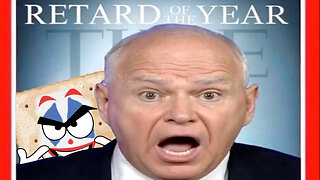 2:17:03
2:17:03
TheSaltyCracker
3 hours agoMeme Warfare Goes Nuclear ReeEEStream 12-07-25
69.8K163 -
 LIVE
LIVE
Adam Does Movies
8 hours agoBest Action Movies! - Live
107 watching -
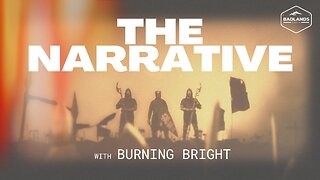 LIVE
LIVE
Badlands Media
18 hours agoThe Narrative Ep. 49: The Trump Doctrine
3,731 watching -
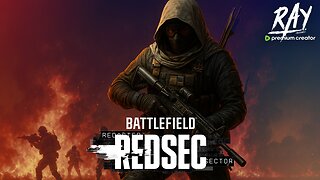 LIVE
LIVE
This is the Ray Gaming
1 hour agoThe Fire Rises | Rumble Premium Creator
44 watching -
 LIVE
LIVE
Joker Effect
1 hour agoDRAMA NEWS! KICK CRINGE AWARDS?! LONEWOLF INTERVIEW!??? !Shock in Chat for details. RECIEPTS HERE!
310 watching -
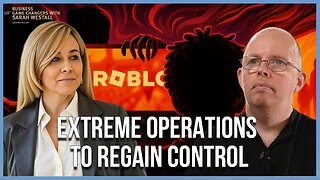 1:09:13
1:09:13
Sarah Westall
3 hours agoThe Psychological Warfare Behind the Headlines w/ Mike Robinson
9.91K -
 2:18:57
2:18:57
vivafrei
13 hours agoEp. 294: Pipe Bomber Caught? Pfizer Fraud before Appeals! Venezuela Boat Strikes! EU v. Elon & MORE!
191K110 -
 LIVE
LIVE
EricJohnPizzaArtist
2 days agoAwesome Sauce PIZZA ART LIVE Ep. #72: John Lennon
240 watching -
 LIVE
LIVE
meleegames
2 hours agoSteam Roulette Sunday! - Chaos Is Back in Town
43 watching
